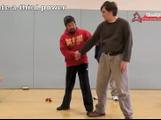Ping Wei is one of Master Chen Zhonghua’s indoor disciples. He lives and teaches Chen Style Taijiquan Practical Method in Phoenix, AZ. USA.
August 28, 6:30am, Phoenix, AZ. Temp: 35 C.
It’s a dog day to do taiji. The heat just drain your energy out. But I went anyway because I have no excuses to miss the class. When we were doing the circles, Gerry mentioned that in one of Master Chen’s video, Master Chen particularly emphasized that the rear hip should be lower than the front side one. OK, here is my story.
It must be 6 or 7 years ago when Master Chen did an Yilu correction on me. One of the correction was to let me get lower (sink) after each form. So I practiced that way for a year or two. When I finally had another chance to do Yilu in front of Master Chen, he corrected me again by saying “don’t drop low.” Couple of more years later, I finally realized how different among the words “low”, “sink”, “drop”, and “down”. There is no too much difference in their literally meaning. I can change the blog title to “Get down, but don’t get down”, or “Sink, and don’t sink”. The difference is between internal and external.
When Master Chen first told me to get low, to sink, I took it literally, I did it by lowering my structure. When Master Chen told me not to get low, not to drop, that means you don’t need to get your physical structure low, but you still can and should get your energy low. YOU GET LOW INTERNALLY. Ah, that’s your intention.
Taiji (or I should particularly say “Practical Method”) is full of dilemma. But, if you start to understand what ‘s out, what’s in, things become clear. Move, don’t move; sink, don’t sink; drop, don’t drop.
Keep practicing.



{ 9 comments… read them below or add one }
This is indeed a big dilemma for students. However, my understanding is that sinking refers to downward rotation of the joints and, like you said, not downward movement of the body. I think this could be another way of saying “get low internally”.
Last summer I wrote an article on this site, which recorded a lesson from Master Chen called “Sinking vs. Downward”. Master Chen addressed this issue with a very useful analogy that I wrote down there. Thanks for raising this crucial topic, and also greetings from Edmonton!
Khamserk post is here http://practicalmethod.com/2010/07/sinking-vs-downward/
His other posts can be found By clicking on the author link of that post or http://practicalmethod.com/author/khamserk/
For me, I started to understand ‘sink’ only after developing leg strength and sensitivity via doing Yilu in wider stance. My take is when done successfully there is a feeling of connected body to the ground
Thanks, Wilkin, for posting Khamserk’s link. Khamserk, your notes are great. Somehow, I missed your post last year.
The notes are really great. Last year on the mountain, i had my difficulties in understanding principles and using them. But now things become much more clearer and present on the body. When i just went through Khamserk´s post i had to smile because of all the condensed taiji wisdom. Very practical.
“YOU GET LOW INTERNALLY. Ah, that’s your intention”
” Sinking is not going down, it is a rotation.”
” It is that 1 degree of difference which makes the Taiji work ”
The three quotes, i think, represent the “dilemma” as Pingwei put it quite well.
One more thing i would like to comment on.
Pingwei, you said : “Taiji (or I should particularly say “Practical Method”) is full of dilemma.”
Actually, this is false. The dilemma is, that your mind and/or body is still full of restriction.
This discussion is very enlightening. My take on this is that “sink” is not a physical movement. It is to put one’s own strength or weight directly on the ground, without restrictions
“It is to put one’s own strength or weight directly on the ground, without restrictions”
To do that efficiently, you have to know where the weight actually is. That requires a center on the body.
Maybe we can get a sense of the bigger context using a comment from Master Chen in a July workshop in Edmonton. He said that unless you consciously lock the body downward every thing will always go up or “pop”, when this happens energy “leaks out”. Using the front shoulder and rear Kua as an example, you can say that when they both sink then the front hand and rear foot get closer to being a straight line or a “stick” the result is that when your opponent uses force on the hand (in reality any part) then they are essentially hitting the floor and this causes them to bounce off or become hurt. According to Master Chen, his teacher GM Hong was only interested in things that can be explained physically and I think the actual physical action that creates sinking is the downward rotation of the joints. By creating a straight line between the point of contact and the rear foot you put the opponents weight “directly on the ground”.